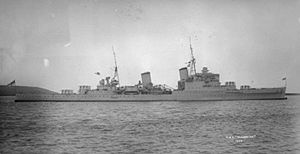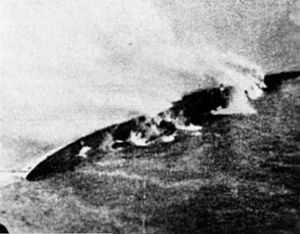HMS Gloucester (62) facts for kids

Gloucester at anchor, 1939
|
|
Quick facts for kids History |
|
|---|---|
| Name | Gloucester |
| Namesake | Gloucester |
| Builder | Devonport Dockyard |
| Laid down | 22 September 1936 |
| Launched | 19 October 1937 |
| Completed | 31 January 1939 |
| Identification | Pennant number: 62 |
| Nickname(s) | "The Fighting G" |
| Fate | Sunk by German aircraft, 22 May 1941 |
| General characteristics (as built) | |
| Class and type | Town-class light cruiser |
| Displacement | |
| Length | 588 ft (179.2 m) |
| Beam | 62 ft 4 in (19.0 m) |
| Draught | 20 ft 7 in (6.3 m) |
| Installed power |
|
| Propulsion | 4 × shafts; 4 × geared steam turbines |
| Speed | 32 knots (59.3 km/h; 36.8 mph) |
| Range | 6,000 nmi (11,000 km; 6,900 mi) at 14 knots (26 km/h; 16 mph) |
| Complement | 800–815 |
| Armament |
|
| Armour |
|
| Aircraft carried | 2 × Supermarine Walrus flying boats |
| Aviation facilities | 1 × catapult |
HMS Gloucester was a light cruiser built for the Royal Navy in the late 1930s. She was part of the "Town-class" ships. Gloucester was put into service just before World War II began in August 1939.
The ship first served in Asia and then moved to the Indian Ocean and South Africa. Her job was to look for German ships that were attacking trade vessels. In mid-1940, she joined the Mediterranean Fleet. There, she spent a lot of time protecting convoys (groups of ships) going to Malta.
Gloucester took part in the Battle of Calabria in 1940 and the Battle of Cape Matapan in 1941. Sadly, German dive bombers sank her on 22 May 1941 during the Battle of Crete. Out of 807 crew members, 722 were lost. Gloucester earned the nickname "The Fighting G" because she won five special awards for bravery in less than a year.
Contents
Ship Design and Features
The Town-class light cruisers were built to match similar Japanese ships from the early 1930s. The last three ships, including Gloucester, were made bigger. This allowed them to carry more equipment for controlling their guns and to have thicker armor.
Size and Power
Gloucester weighed about 9,400 long tons (9,550 tonnes) when empty. When fully loaded, she weighed about 11,650 long tons (11,837 tonnes). The ship was 591 feet 6 inches (180.3 meters) long. She was 62 feet 4 inches (19 meters) wide and had a depth of 20 feet 7 inches (6.3 meters) underwater.
Four powerful steam turbine engines moved the ship. These engines got their steam from four large boilers. Together, they produced 82,500 horsepower. This power allowed Gloucester to reach a top speed of 32 knots (59 km/h; 37 mph). The ship could travel 6,000 nautical miles (11,000 km; 6,900 mi) at a speed of 14 knots (26 km/h; 16 mph). The crew usually had between 800 and 815 officers and sailors.
Weapons and Protection
The Town-class ships had twelve 6-inch (152 mm) guns. These were placed in four triple gun turrets. The turrets were named 'A', 'B', 'X', and 'Y' from front to back.
For defense against aircraft and smaller ships, Gloucester had eight 4-inch (102 mm) dual-purpose guns. These guns could shoot at targets in the air or on the sea. The ship also had smaller anti-aircraft guns, including two quadruple 2-pounder (40 mm) "pom-pom" guns. There were also two quadruple 0.5-inch (12.7 mm) machine guns. For attacking enemy ships underwater, Gloucester carried two triple mounts for 21-inch (533 mm) torpedo tubes.
Gloucester had armor to protect its important parts. The sides of the engine rooms and ammunition storage areas were protected by 4.5 inches (114 mm) of armor. The top of these areas had 2 inches (51 mm) of armor. The main gun turrets had armor that was between 1 and 2 inches (25 to 51 mm) thick.
Building and Early Service
Gloucester was the ninth ship to carry that name in the Royal Navy. Her construction began on 22 September 1936. Princess Alice, Duchess of Gloucester, launched the ship on 19 October 1937. This is a special ceremony where a ship is officially put into the water for the first time.
During her sea trials in November 1938, Gloucester reached an average speed of 31.92 knots. This test happened off the coast of Talland, Cornwall.
After being finished on 31 January 1939, Gloucester became the lead ship of the 4th Cruiser Squadron. This squadron was based at the China Station. She served there until World War II started in September.
In November, Gloucester and a French ship searched the Indian Ocean for a German trade raider called Admiral Graf Spee. They did not find it. In December, she moved to Simonstown, South Africa. There, she patrolled the Atlantic Ocean to look for other German ships. Many South African sailors served on Gloucester during this time.
Service in the Mediterranean Sea
In May 1940, Gloucester moved to the 7th Cruiser Squadron of the Mediterranean Fleet in Alexandria, Egypt. Soon after Italy joined the war in June, Gloucester and her sister ship, Liverpool, attacked Tobruk, Libya. They sank a small Italian minesweeper.
Later, the 7th Squadron was protecting convoys to Malta. On 28 June, British planes spotted an Italian convoy. The squadron was ordered to attack and sank the Italian destroyer Espero. This used a lot of ammunition.
On 7 July, the Mediterranean Fleet sailed to protect more Malta convoys. Italian planes spotted them. The next day, a bomb from an Italian bomber hit Gloucester's bridge. The bridge is where the ship is steered. This attack killed 18 crew members, including the captain. The ship could not be steered from the bridge for a while. The crew had to use the steering position at the back of the ship.
Even with a damaged bridge, Gloucester stayed with the fleet. She took part in the Battle of Calabria on 9 July. She was ordered to protect the aircraft carrier Eagle. Repairs to Gloucester were finished by the end of August. She then helped with "Operation Hats." In September, Gloucester and Liverpool carried 1,200 troops to Malta. For the rest of the year, Gloucester mostly escorted convoys to Greece and Malta. She also protected the aircraft carrier Illustrious during the Battle of Taranto on 11 November.
On 11 January 1941, Gloucester and Southampton were leaving Malta. They were supporting "Operation Excess," which involved several convoys. German Junkers Ju 87 "Stuka" dive bombers attacked them. Gloucester was hit by a 250 kg (550 lb) bomb. Luckily, the bomb did not explode after going through five decks. Southampton was hit by at least two bombs. It caught fire and was badly damaged. Another ship, Orion, had to sink Southampton with torpedoes because it could not be saved.
Battle of Cape Matapan
On 27 March 1941, Gloucester left Piraeus, Greece. She was heading to Souda Bay, Crete. This was part of a plan by Vice-Admiral Andrew Cunningham to trap and destroy a large part of the Italian Fleet. British intelligence had learned about the Italian plan.
The Italians found the British ships first. Three Italian heavy cruisers opened fire on Gloucester and other British ships from a long distance. Only Gloucester fired back as the British tried to get away. The Italian admiral later tried to trap the British cruisers between his ships and his battleship, Vittorio Veneto.
The British ships were surprised when Vittorio Veneto started firing at them. The Italian guns had problems, and they did not hit Gloucester or Orion. The British ships made smoke screens and turned south. An attack by British torpedo planes made the Italian admiral turn back. Later, another torpedo plane attack damaged the Vittorio Veneto and slowed it down.
That night, British ships found three Italian heavy cruisers that had been sent to help a damaged ship. Admiral Cunningham's three battleships quickly sank all three Italian heavy cruisers from very close range.
The Sinking of HMS Gloucester

Gloucester attacked targets in Libya many times during April 1941. She also helped protect another convoy to Malta. Then, with three battleships and destroyers, she attacked Tripoli harbor on the night of 20/21 April. This attack was successful.
At the end of April, Gloucester briefly moved to Gibraltar. She then escorted a convoy to Malta and rejoined the Mediterranean Fleet in early May.
To stop the German invasion of Crete, Admiral Cunningham divided his fleet into several groups. These groups would try to stop German ships carrying troops. On 20 May, German paratroopers landed on Crete. Gloucester was made the command ship of Force B. Her job was to stop any German attempts to send more troops to the island by sea.
Force B patrolled through the night but did not find any enemy ships. On the morning of 21 May, they joined up with another British force. Later that day, Allied planes spotted a German and Italian convoy. Forces B, C, and D were ordered to intercept it.
Force B did not find any enemy naval ships, but at 6:30 AM on 22 May, about fifty German "Stuka" dive bombers attacked them. Gloucester and Fiji were damaged by bombs that exploded very close to them.
The British forces met up around 8:30 AM. They were asked to report how much anti-aircraft ammunition they had left. Gloucester had only 18% of its anti-aircraft ammunition remaining. Other cruisers were ordered to return to Alexandria to rearm. However, Gloucester and Fiji stayed with the main force.
Later, Gloucester and Fiji were sent to help rescue survivors from a sunken destroyer, Greyhound. Admiral Cunningham later said that the admiral in charge did not know how low Gloucester and Fiji's ammunition was. An order was sent to call both ships back at 2:57 PM.
While in the Kythira Strait, about 14 miles (26 km) north of Crete, German "Stuka" bombers attacked Gloucester and Fiji. Between 3:30 PM and 3:50 PM, Gloucester was hit by several bombs. Because of the heavy air attacks, the decision was made to leave her behind. Fiji, also under heavy fire, dropped rafts for survivors as it passed Gloucester. Fiji itself was sunk a few hours later.
A group of destroyers was sent to look for survivors of both Gloucester and Fiji that evening. However, they were redirected to attack a German airfield. Eventually, German forces picked up the survivors and took them to Kythira. Out of 807 men on board Gloucester when she sank, only 85 survived. Two more later died as prisoners.
The sinking of Gloucester was discussed in a BBC program. It said that sending Gloucester, alone and low on fuel and ammunition, into danger was a "serious mistake." Also, not trying to rescue survivors after dark was "against normal Navy practice." A survivor said, "The Navy tradition is that after a ship sinks, another vessel is sent back to pick up survivors under cover of darkness. That did not happen and we do not know why. We were picked up by Germans."
After Gloucester and Fiji were lost because their anti-aircraft ammunition ran out, all British cruisers were told to always keep at least 40% of their anti-aircraft ammunition.
The wreck of Gloucester is a protected site. This means it cannot be disturbed. Among the crew members lost was a famous football player, Norman Catlin.
See also
 In Spanish: HMS Gloucester (62) para niños
In Spanish: HMS Gloucester (62) para niños

